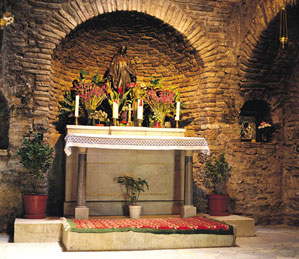Legend has it that the Virgin Mary, accompanied by Saint John, came to Ephesus at the end of her life, circa 37-45 A.D. Renaissance church historians mentioned the trip, and it is said that local Christians venerated a small house near Ephesus as Mary’s.
St. John, in his Gospel, tells us that Jesus, before dying on the Cross, entrusted to him the care of his Mother when he said (saying): “Here is your mother” and from that hour St. John took her to his own. The “Acts of the Apostles” relate how after the death of Christ, his followers were persecuted in Jerusalem. St. Stephen was stoned in 37 A.D., St. James was beheaded in 42 A.D. And any further relate how they divided the world between them for preaching the Gospel, and St. John was given Asia Minor. Now, Mary had been given to his care and with the persecution, probably brought her with him to Asia Minor. There are two evidences confirming historically the facts:
1- the presence of the tomb of St. John in Ephesus, and
2- the presence of the first Basilica of the world dedicated to the Blessed Virgin. In the early days of the Church, places of worship were only dedicated to persons who had lived or died in the locality.
Also, the Ecumenical Council of 431 was held in Ephesus in this Basilica for the definition of the dogma of the Divine Motherhood of Mary. The Council Fathers write about Nestorius: “...after his arrival to Ephesus where John the Theologian and the Holy Virgin Mary, Mother of God...”

There is another confirmation in the oral tradition of the villagers of Kirkindje. These people were the descendants of the christians of Ephesus. They had passed from generation to generation, the belief of the death of Mary in this place, so they called “Panaghia Kapulu”. They have kept this tradition alive through the annual pilgrimage of 15th of August.
In the 19th century a book named “The life of the Blessed Virgin” was published in Germany. The material for this book come from the revelations of a stigmatized Nun, Anna Catherina Emmerich. She was an invalid and had never left Germany. In her visions she described with amazing accurancy the hills of Ephesus and the house where she saw the Blessed Virgin spending her last days. Accordingly, two scientific expeditions were organized, and they found this place perfectly agreeing with her description.
The Chapel was rebuilt upon the original foundations that have been determined to date as of the 1st and 4th centuries. Part of the building is of the 7th century and the last restoration took place in 1951.
In 1967, Pope Paul VI visited the site, where a chapel now stands, and confirmed the authenticity of the legend. A small traditional service, celebrated by Orthodox and Muslim clergies on 15th of August each year in honour of Mary’s Assumption into heaven, is now the major event here. To Muslims, Mary is Meryemana, Mother Mary, who bore Isa Peygamber, the Prophet Jesus. So, the place is considered holy not only by Christians but Muslims as well. The shrine is visited by patients seeking cure; offers are made and vows taken.
Holy Mass
Sunday : 10.30 A.M
Week days: November - March: 7.30 A.M
April - October: 7.00 A.M
Meryem Ana Evi 35922 Selcuk - Izmir - Turkiye
Telephone: +90 232 894 10 05
+90 530 469 08 44

